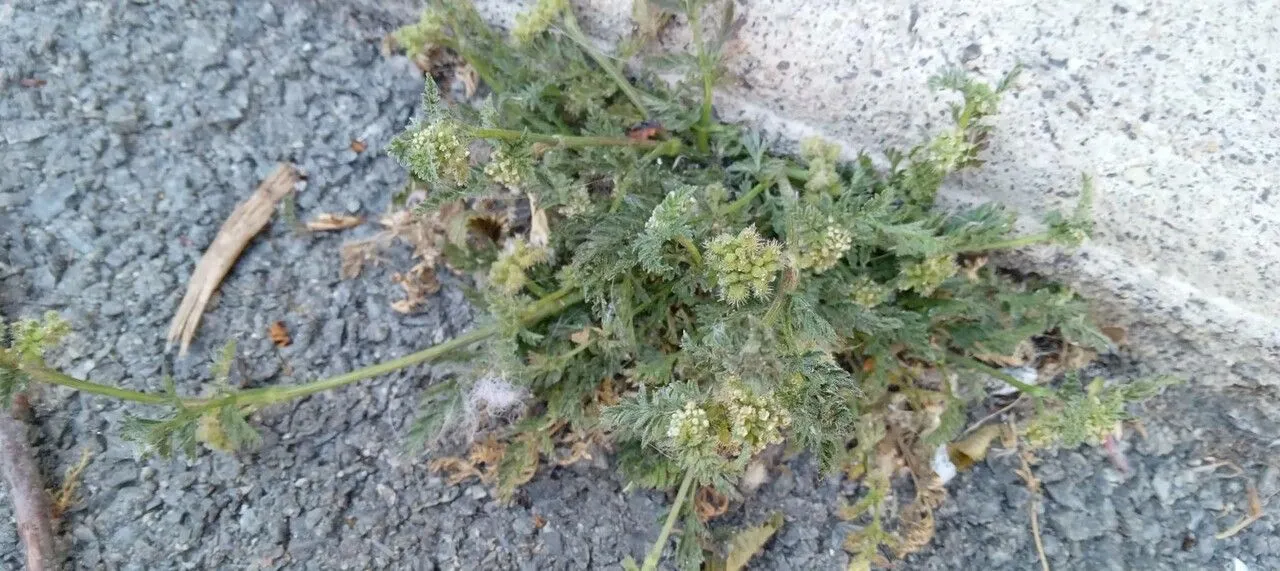
Author: (L.) Gaertn.
Bibliography: Fruct. Sem. Pl. 1: 82 (1788)
Year: 1788
Status: accepted
Rank: species
Genus: Torilis
Vegetable: False
Observations: Macaronesia, W. Europe to Medit. and W. Himalaya
Hedge-parsley, known scientifically as Torilis nodosa, is a plant species belonging to the Apiaceae family. First described in the reference work “Fruct. Sem. Pl.” in 1788 by the botanist Gaertner, marked by the authority initials (L.) Gaertn., this species has an extensive distribution that spans across various regions including Macaronesia, Western Europe, the Mediterranean, and the Western Himalayas.
Characterized by its delicate and intricate floral structures, Hedge-parsley thrives in diverse climates and terrains. The plant’s typical habitats include hedgerows, uncultivated lands, and meadows, where it often intertwines with the local vegetation, forming characteristic hedges. Its inflorescences usually display umbels of small flowers that can easily be mistaken for those of other members of the Apiaceae family due to their similar structure, yet it holds distinctive botanical features.
From a morphological standpoint, Torilis nodosa stands out due to its finely divided leaves and erect stems that can reach varying heights, contributing to its adaptability in different environmental conditions. The species has developed a notable resilience, enabling it to compete with other flora within its shared habitats.
Ecologically, Hedge-parsley is an essential component of its local ecosystems, providing food and shelter for various insect species which play crucial roles in the pollination process. Additionally, it serves as a natural deterrent for land erosion due to its robust root system.
In summary, Hedge-parsley (Torilis nodosa), with its broad geographical span from the temperate regions of Western Europe to the warmer Mediterranean and across to the Himalayan foothills, exemplifies the adaptive nature of the Apiaceae family. Its historical documentation by Gaertner in the 18th century anchors its scientific recognition, making it a plant of significant interest both botanically and ecologically.
Deu: knoten-borstendolde, knotiger klettenkerbel, knäuel-klettenkerbel
Eng: knotted hedge-parsley, knotted hedgeparsley, hedge-parsley, knotted-hemlock, knotted-parsley, knotted bur parsley, knotted hedge parsley
Dan: knudret randfrø
Hun: csomós tüskemag
Nld: knopig doornzaad
Swe: knutkörvel
Por: laponina, salsinha, salsinha-de-cabeça-rente
Fra: torilis noueuse, torilis noueux
Ces: tořice uzlovitá
Cym: berllys, clwm eilun-berllys, cwlwm eilun, eilun, oliaren glymog, troed y cyw clymog, troed-y-cyw clymog
En: Hedge-parsley, Knotted hedge-parsley, Knotted-hemlock, Knotted-parsley, Knotted hedgeparsley, Knotted Bur Parsley, Knotted hedge parsley
Cs: Tořice uzlovitá
Da: Knudret randfrø
Nl: Knopig doornzaad, Kluwendoornzaad
Fr: Torilis noueuse, Torilis noueux, Manchotte, Torilis à fleurs glomérulées
De: Knoten-Borstendolde, Knotiger Klettenkerbel, Knäuel-Klettenkerbel, Knäuelkerbel
He: גזיר המפרקים
Hu: Csomós tüskemag
It: Lappolina nodosa
Pt: Laponina, Salsinha, Salsinha-de-cabeça-rente
Pt-br: Cerefólio-nodoso, Cerefólio-nodoso-de-cerca
Es: Cachurro
Sv: Knutkörvel
Cy: Berllys, Clwm Eilun-Berllys, Cwlwm Eilun, Eilun, Oliaren Glymog, Troed y Cyw Clymog, Troed-y-Cyw Clymog
Taken Apr 23, 2018 by huy HO (cc-by-sa)
Taken May 29, 2022 by Fabrice Rubio (cc-by-sa)
Taken Mar 31, 2009 by EOL − biodivinf (cc-by-nc-sa)
Taken May 18, 2016 by eva.a.boyer (cc-by-sa)
Taken Mar 19, 2019 by Ricardo Lemaur (cc-by-sa)
© copyright of the Board of Trustees of the Royal Botanic Gardens, Kew.
© copyright of the Board of Trustees of the Royal Botanic Gardens, Kew.
© copyright of the Board of Trustees of the Royal Botanic Gardens, Kew.
Taken May 20, 2022 by Fabrice Rubio (cc-by-sa)
Taken May 29, 2022 by Fabrice Rubio (cc-by-sa)
Taken May 25, 2022 by Jocelyne Durand (cc-by-sa)
Taken Jan 29, 2021 by Lezaun Juan Antonio (cc-by-sa)
Taken Apr 19, 2021 by Antonio López Rodríguez (cc-by-sa)
Taken May 8, 2016 by Tela Botanica − Liliane ROUBAUDI (cc-by-sa)
Taken Jul 7, 2014 by Tela Botanica − Dominique REMAUD (cc-by-sa)
Taken Oct 10, 2020 by Mariangela Malandrini (cc-by-sa)
Taken May 8, 2016 by Tela Botanica − Liliane ROUBAUDI (cc-by-sa)
Taken May 8, 2016 by Tela Botanica − Liliane ROUBAUDI (cc-by-sa)
Taken May 29, 2022 by Fabrice Rubio (cc-by-sa)
Taken May 20, 2022 by Fabrice Rubio (cc-by-sa)
Taken May 20, 2022 by Fabrice Rubio (cc-by-sa)
Taken May 8, 2016 by Tela Botanica − Liliane ROUBAUDI (cc-by-sa)
Taken Jun 21, 2016 by Tela Botanica − Hugo DAILLAN (cc-by-sa)
Taken Apr 13, 2019 by Delporte Dylan (cc-by-sa)
Taken Aug 21, 2018 by Catherine Bouvard (cc-by-sa)
Taken May 1, 2022 by Raffaello 2 Garofalo (cc-by-sa)
Taken May 17, 2017 by Hélène Launay (cc-by-sa)
Taken Jan 1, 1900 by EOL − Encyclopedia of Life (cc-by-nc-sa)
Taken Jan 1, 1900 by EOL − Encyclopedia of Life (cc-by-nc-sa)
Taken Jun 30, 1852 by Tela Botanica − Herbier PONTARLIER-MARICHAL (cc-by-sa)
Taken Jun 21, 2016 by Tela Botanica − Hugo DAILLAN (cc-by-sa)
Taken May 8, 2016 by Tela Botanica − Liliane ROUBAUDI (cc-by-sa)
Growth habit: Forb/herb
Ph maximum: 7.5
Ph minimum: 7.0
Light: 8
Atmospheric humidity: 4
Soil nutriments: 7
Family: Myrtaceae Author: (F.Muell.) K.D.Hill & L.A.S.Johnson Bibliography: Telopea 6: 402 (1995) Year: 1995 Status:…
Family: Rubiaceae Author: Pierre ex A.Froehner Bibliography: Notizbl. Bot. Gart. Berlin-Dahlem 1: 237 (1897) Year:…
Family: Sapindaceae Author: Koidz. Bibliography: J. Coll. Sci. Imp. Univ. Tokyo 32(1): 38 (1911) Year:…
Family: Asteraceae Author: A.Gray Bibliography: Pacif. Railr. Rep.: 107 (1857) Year: 1857 Status: accepted Rank:…
Family: Fabaceae Author: Medik. Bibliography: Vorles. Churpfälz. Phys.-Ökon. Ges. 2: 398 (1787) Year: 1787 Status:…
Family: Aspleniaceae Author: (Cav.) Alston Bibliography: Bull. Misc. Inform. Kew 1932: 309 (1932) Year: 1932…